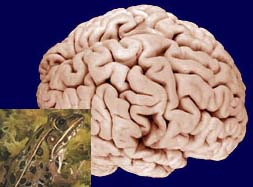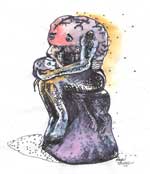Serendip is an independent site partnering with faculty at multiple colleges and universities around the world. Happy exploring!
Pain, I-function, personal responsibility, seeing

|
Biology 202
|
 |
Class discussion - 8 April
Pain thresholds can be different because of varied nervous system architecture. Pain can be environmentally informed/ "out there" when individual reaction and experience of pain is influenced by the reaction of others to the damage or cause of pain. For example, when a child gets hurt they will calm down and forget about the pain faster if the parent reacts calmly. Pain "in here" is very real but cannot be gaged by anyone other than the individual, as emotional pain is often masked behaviorally to the outside observer. Physical experience of pain can either begin before or after the individual sees the physical evidence, for example
pain from a paper cut can be experienced before you see the cut(which causes you to look for the source of pain) or after you see the cut (you may not experience pain until your visual sensory information tell you
that you should). We may never have the full experience of pain because signally pathways will stop signaling once threshold is reached even if more signals are being transmitted from the damaged area. Also, the source of physical pain may be internal due to a mismatch between corollary discharge signals and sensory information- like in the case of phantom limbs. We concluded that pain indeed can be physical, emotional,
objective, subjective, "in here" and "out there."
Group members: Anne Kauth, Margaux Kearney, Zoe Fuller-Young, Greta Flaherty, Caroline Heffernan, Caroline Feldman, Jessica Varney, Nelly Khaselev, Maggie Simon, Kendra Smythe, Penn Tong
As a group, we had come to the consensus that there was a spectrum of consciousness that we all possessed and that our "I-Function" activeness directly corresponded to the level of consciousness that was being experienced. For instance, if someone were blacked out from drinking, they may act silly but its because the "I-Function" is in a reduced state of activeness since the state of consciousness of the individual is lower than when they may not be intoxicated. In regards to the second question, our group believed that the "I-Function" is not distinct, is stable in the manner that it is ever present but may not always be extremely active and that it is in fact a useful part of our daily lives.
Group members: Lyndsey Carbonello, Paife Safyer, Meredith Tyohey, nana Asabere, Marie Sager, Isabelle Winer, Kendrya Sykes, Mahvish Qureshi, Emily Alspector, Jean Chung, Jenn Wong, EB VerHoeve and
Tara Raju.
In our discussion of the I-function and when individuals can be held responsible for their actions we started our investigation by determining one instance in which the individual was absolutely responsible for his or her actions, and one where the individual was not. We determined that while a healthy individual with a healthy I-function ("healthy" here being used to describe culturally condoned and normative conditions) is absolutely responsible for the actions resulting from choices she or he makes. On the other hand, some one who does not possess a healthy I-function, like an infant, cannot be held responsible for their actions.
Between these black and white examples though, there is a considerable gray area. What about individuals with unhealthy I-functions? The actions of individuals with healthy I-functions, but which do not result from choices these individuals make? And what about individuals with "immature" I-functions, like young children or animals? (And even within this category there seems to be a huge range of variation.)
To answer these questions we must turn to other questions: what do we mean by "choices"? By "responsibility"? What is the relationship between morality and legality? Can someone be morally innocent of any wrong-doing but still legally culpable? To answer these questions we will need to engage in a much bigger dialog.
Apart from these larger questions, in our discussion we concluded that the extent to which a person has a properly working I-function dictates the degree to which he or she can be held responsible for the actions resulting from his or her choices.
Group members: Rica Delacruz, Anna G., Paul Bloch, Jackie Morano, Heather Foley, Molly Pieri (others?)
It is possible to "see" without input and without the I-function. One example of this is that the nervous system fills in blind spots in one's vision, thereby expanding one's perceptual capabilities. Hallucinations are another way that the nervous system "sees" without an actual input. Finally, there is the ability for one to imagine, in one's mind, scenarios, people, places that do not exist before oneself. This is also manifest in the ways in which children play together and use their imaginations and conjure up imaginary friends.
Group members: Michelle Khilji, Lisa Lamprou, Michelle Crepeau, Caitlin Jeschke, Angel Desai, Sophie Feller



Comments
Post new comment